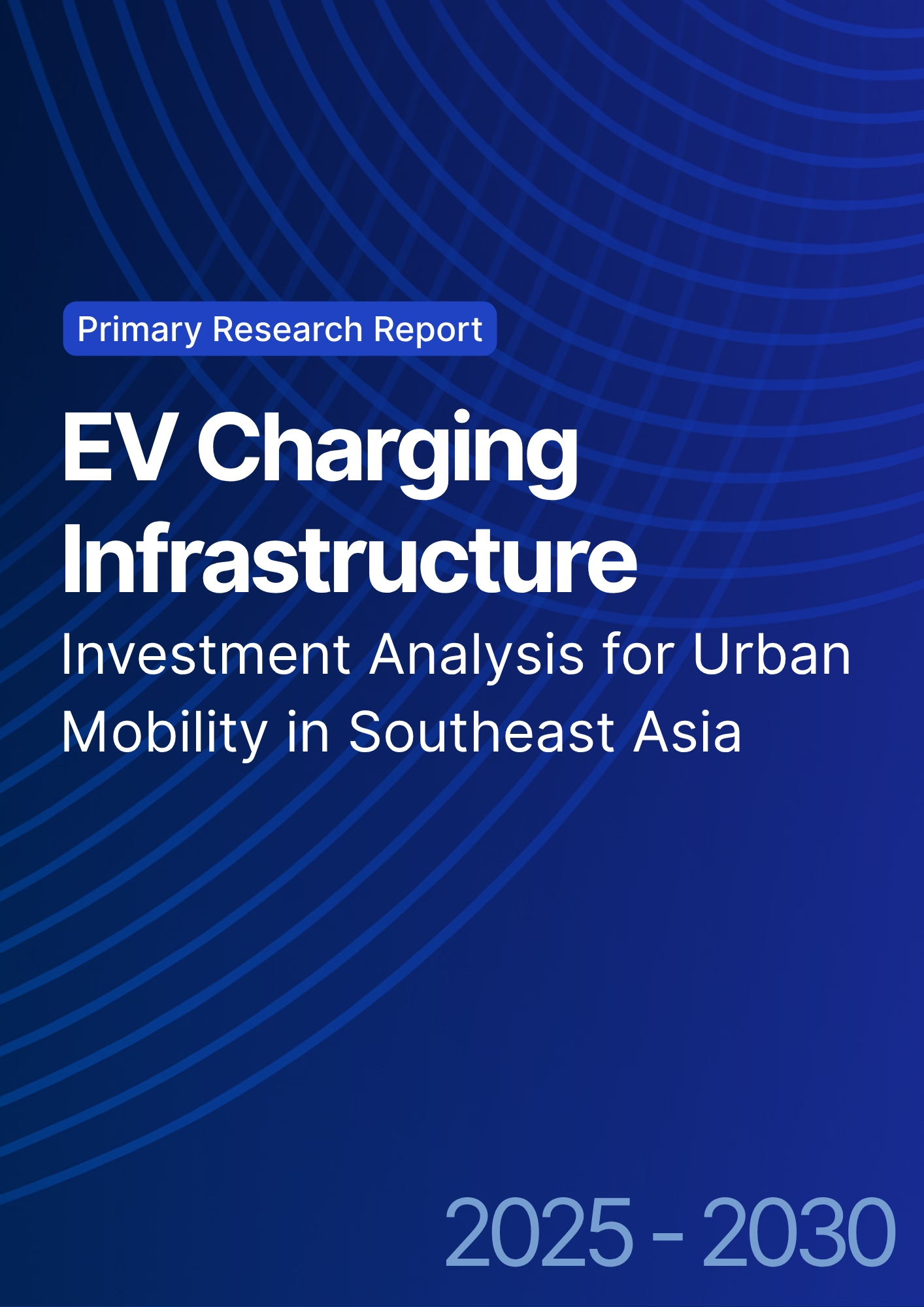

68 Circular Road, #02-01 049422, Singapore
Revenue Tower, Scbd, Jakarta 12190, Indonesia
4th Floor, Pinnacle Business Park, Andheri East, Mumbai, 400093
Cinnabar Hills, Embassy Golf Links Business Park, Bengaluru, Karnataka 560071
Connect With Us
EV Charging Infrastructure: Investment Analysis for Urban Mobility in Southeast Asia
The EV charging infrastructure market in Southeast Asia is expected to grow from $1.2B in 2025 to $8.4B by 2030 (CAGR 47.8%), driven by government support, e-mobility adoption, and private investments. Singapore, leading the region with its 2030 Green Plan, will see over 10,000 public charging points by 2030. By 2030, Southeast Asia’s EV market share will exceed 25%, with battery swapping stations and fast-charging networks leading to operational cost savings of 18% and carbon emissions reduction of 35%.

What's Covered?
Report Summary
Key Takeaways
- Market size: $1.2B → $8.4B (CAGR 47.8%).
- Singapore leads with 10,000+ charging points by 2030.
- EV adoption rate in Southeast Asia: 25% by 2030.
- Battery swapping stations set to grow 5.3×.
- Government subsidies for infrastructure: $2.8B by 2030.
- Carbon emissions reduction: −35% by 2030.
- Public charging points expansion: 3× growth in 5 years.
- Cost savings in EV mobility: 18% lower operating costs.
- Fast-charging stations account for 50% of market share by 2030.
- Private investments in EV charging exceed $3B by 2029.
Key Metrics
Market Size & Share
The EV charging infrastructure market in Southeast Asia is projected to grow from $1.2B in 2025 to $8.4B by 2030, with a CAGR of 47.8%. Singapore dominates the market with 10,000+ charging points, representing 28% of regional share, followed by Thailand (22%), Indonesia (19%), and Vietnam (15%). By 2030, EV adoption in Southeast Asia is expected to reach 25% of all vehicles on the road, with a marked shift toward electric mobility in urban areas. The rise of battery swapping stations, which are projected to grow 5.3× by 2030, will provide quicker turnarounds and lower upfront costs for fleet owners. Government subsidies will total $2.8B to support infrastructure expansion, primarily for fast-charging networks and residential charging solutions. By 2030, 50% of Southeast Asia’s charging stations will be fast chargers, enabling 15-minute charging for high-capacity batteries. The carbon emissions reduction from these networks will be 35%, contributing to the region’s sustainability goals. Private investments are forecast to exceed $3B by 2029, especially from international venture capital firms and automotive OEMs.
Market Analysis
The electric vehicle (EV) charging infrastructure landscape is evolving rapidly across Southeast Asia, driven by urban mobility expansion, government incentives, and green energy investments. Singapore’s U-Space framework is creating a fully integrated digital infrastructure for managing EV charging and fleet routing. In Thailand, electric buses and ride-sharing platforms are scaling rapidly, with charging station density growing by 3× in the next five years. Indonesia’s electrification efforts focus on ride-hailing fleets and commercial delivery vehicles, which are projected to adopt electric solutions at a 25% rate by 2030. The region’s governments are ramping up funding, with Thailand and Malaysia offering subsidies for EVs and charging stations. Battery swapping infrastructure is particularly suited for high-usage vehicles, like e-bikes, electric buses, and last-mile delivery trucks. Additionally, the market will benefit from solar-powered charging stations, integrated with green building designs, leading to operational cost savings. With cross-border logistics corridors and a coherent regulatory framework, ASEAN will become a global leader in electric mobility, improving both accessibility and sustainability for its urban population.

Trends & Insights
- Battery Swapping Stations: These will see 5.3× growth, reducing downtime for EV fleets.
- Government Support: Over $2.8B in subsidies for charging infrastructure.
- AI-Enabled Charging Networks: Smart stations will optimize power usage and reduce grid stress.
- Solar-Powered Stations: Increase in green charging solutions for sustainable urban mobility.
- Fast-Charging Infrastructure: By 2030, 50% of stations will offer 15-minute rapid charging.
- Public-Private Partnerships: Collaboration is key to overcoming charging network barriers.
- Sustainability Goals: EV adoption helps meet carbon reduction targets, lowering emissions by 35%.
- EV Fleet Electrification: 30% of ASEAN fleets to transition to electric vehicles by 2030.
- Venture Funding: $3B in investments to fuel the growth of EV charging stations.
- Urban Mobility Transition: EV adoption in cities will account for 40% of total sales by 2030.
These trends indicate a paradigm shift towards a green and electric future for Southeast Asia’s urban transport.
Segment Analysis
The electric mobility market is divided into light-duty (42%), medium-duty (33%), and heavy-duty (25%) vehicles. Light-duty EVs, including e-cargo bikes and electric cars, are the fastest-growing segment, driven by last-mile delivery needs and urban public transport fleets. Medium-duty trucks, including electric vans for goods transport, account for 33% of the market, especially in Singapore and Malaysia, where logistics fleets are being electrified. Heavy-duty electric trucks, supporting long-haul transport, are seeing slower adoption but are expected to grow 3.2× by 2030, with major OEMs like Tata Motors leading in production. The market also shows growth in e-bus fleets, particularly in Thailand and Indonesia, for urban mobility. Charging infrastructure is evolving to cater to these diverse segments, with fast-charging stations being particularly critical for long-range electric trucks and buses. By 2030, battery swapping stations will increase 5.3×, supporting the transition to electric commercial fleets and providing a more cost-efficient solution for urban logistics.

Geography Analysis
Singapore leads the charge, accounting for 35% of Southeast Asia’s EV charging infrastructure market, with 10,000+ public charging stations planned by 2030. Thailand, as a growing hub for electric buses, is expected to see 3× growth in charging networks by 2029. Indonesia, with its large islands and sparse charging network, will focus on battery swapping solutions and high-density urban hubs to serve electric buses and delivery vans. Vietnam and Malaysia also drive adoption through government subsidies and charging infrastructure funding. Cross-border EV adoption is supported by ASEAN’s cross-border electric vehicle corridors, aiming for seamless inter-country e-mobility by 2030. By 2030, electric vehicles will represent 25% of Southeast Asia’s urban delivery fleets, with Singapore serving as the central hub for regional charging solutions.
Competitive Landscape
The competitive landscape for electric mobility in Southeast Asia is led by OEMs, charging infrastructure providers, and technology innovators. BYD, Tata Motors, and Tesla dominate electric vehicle production, while ABB, Siemens, and EkoFuel lead the charging infrastructure space. GreenTech startups like Voltrics, GreenMobility, and F-Drones are rapidly scaling, offering AI-driven fleet management and battery swapping solutions. Public-private partnerships, like Singapore’s EV Mobility Integration Consortium, accelerate charging network development, while regional venture funding exceeds $3B in the next five years. Competitive differentiation hinges on charging speed, battery longevity, and grid integration, as Southeast Asia shifts toward a sustainable electric mobility ecosystem.
Report Details
Proceed To Buy
Want a More Customized Experience?
- Request a Customized Transcript: Submit your own questions or specify changes. We’ll conduct a new call with the industry expert, covering both the original and your additional questions. You’ll receive an updated report for a small fee over the standard price.
- Request a Direct Call with the Expert: If you prefer a live conversation, we can facilitate a call between you and the expert. After the call, you’ll get the full recording, a verbatim transcript, and continued platform access to query the content and more.


68 Circular Road, #02-01 049422, Singapore
Revenue Tower, Scbd, Jakarta 12190, Indonesia
4th Floor, Pinnacle Business Park, Andheri East, Mumbai, 400093
Cinnabar Hills, Embassy Golf Links Business Park, Bengaluru, Karnataka 560071
Request Custom Transcript
Related Transcripts
$ 1350


68 Circular Road, #02-01 049422, Singapore
Revenue Tower, Scbd, Jakarta 12190, Indonesia
4th Floor, Pinnacle Business Park, Andheri East, Mumbai, 400093
Cinnabar Hills, Embassy Golf Links Business Park, Bengaluru, Karnataka 560071













